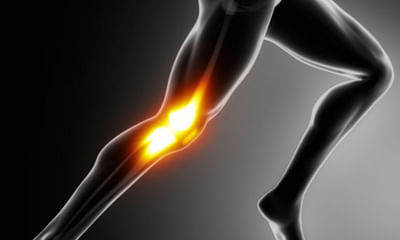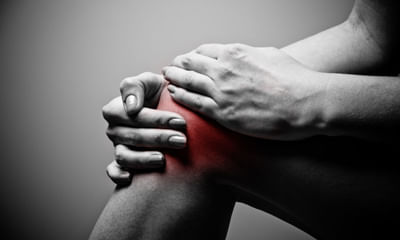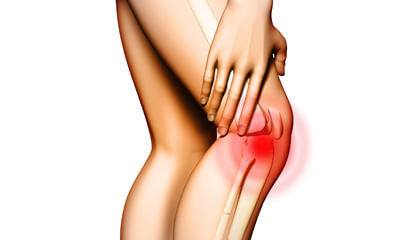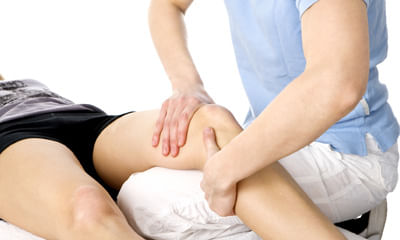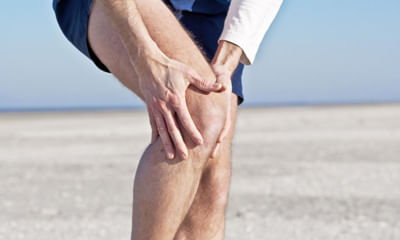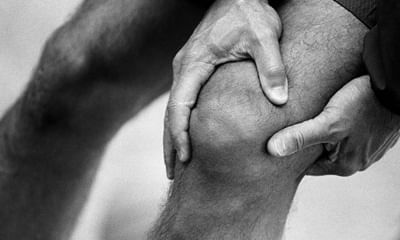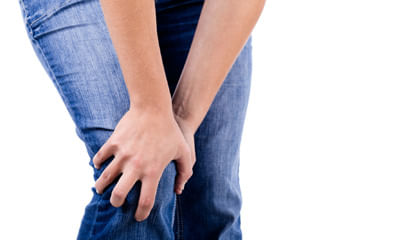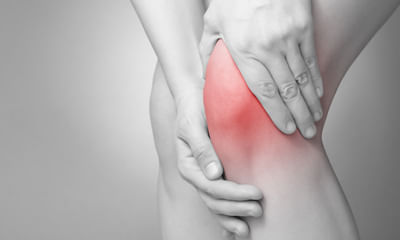Knee Effusion Exercises
A boy aged 14 years suffering with knee pain and swelling. May be knee effusion. Whom to be consulted. ...
Ask Free Question
use icepack for the knees. follow some knee exercises. straight leg raise, wall squats. leg press for knees. daily walking for 30 mins
My husband has a right knee joint pain. Done mri, it says minimal synovial effusion and no abnormalities are seen. It ha ...
Ask Free Question
Hello, dont worry it is just sprain which occur due to sudden jerk in knee. just do knee strenghtning exercises using therabands,towels etc use icepack for knee. keep the knees elevated while sleeping and sitting.
Hii, my husband is 34 years old, he is suffering from knee joint pain. Have done an mri everything seems to be normal. R ...
Ask Free Question
If pain and swelling is not much then he should start knee range of motion exercise and quadriceps strengthening exercise.
I am a 56-year-old lady. All of a sudden I have excruciating pain in my left knee. I had no symptoms before. I am unable ...
Ask Free Question
Hello Ms. lybrate-user let me explain to you what has been happening: the patients with early osteoarthritis usually do not have any complaints for a long time and the first time they approach a doctor is usually when they develop synovitis (swelling) in the knee which is known to occur from time to time in a patient of osteoarthritis. Pain control can be done in 2 ways: oral medicines or injection in the joint; oral medicines take more time and can have some side effects, however injection works faster and without side effects. You can opt for either.
I have knee pain. Mri shows that grade ii chondromalacia patella with minimum streak of joint effusion and grade I signa ...
Ask Free Question
Lie down with one leg bent at a 90-degree angle with the foot flat on the floor and the other leg fully extended. Tighten the quadriceps (thigh muscle) of the straight leg and raise it to a 45-degree angle. Hold the leg in this elevated position for a second or two before slowly lowering it back to the ground. You may require 4-6 weeks of physical therapy treatment, and then several more months of a home stretching and strengthening program to treat your chondromalacia patella. Getting the pain and inflammation under control is the first step. Strengthening exercises. Weak thigh muscles contribute to the strain on your patellar tendon. Exercises that involve lowering your leg very slowly after extending it can be particularly helpful, as can exercises that strengthen all of the leg muscles in combination, such as a leg press. Half squat (do 2 to 3 sets of 10 repetitions)calf raises (do 2 to 3 sets of 10 repetitions)hamstring curl to do this exercise: 1.Stand facing a wall or use a chair for support. Your feet should be hip-width apart. 2.Lift one foot up, bend your knee, and raise your heel toward the ceiling. Go as far as you can, while keeping your upper body still and hips pointing forward. 3.Hold for 5 to 10 seconds. 4.Relax and lower to the starting position. 5.Do 2 to 3 sets of 10 repetitions for each leg. Leg extensions to do this exercise: 1.Sit up tall in a chair. 2.Put your feet flat on the floor, hip-width apart. 3.Look straight ahead, contract your thigh muscles, and extend one leg as high as possible without raising your buttocks off the chair. 4.Pause, then lower to the starting position. 5.Do 2 to 3 sets of 10 repetitions for each leg. Straight leg raises to do this exercise: 1.For this exercise, you can use a mat to add cushioning under your back. 2.Lie down on the floor with one leg bent and one leg straight out in front of you. 3.Contract the quadricep of your straight leg and slowly raise it up off the floor until it’s the same height as your bent knee. 4.Pause at the top for 5 seconds, then lower to the starting position 5.Do 2 to 3 sets of 10 repetitions for each leg. Side leg raises to do this exercise: 1.Lie on your side with your legs stacked on top of each other. Cradle your head in your hand, and place your other hand on the floor in front of you. 2.Raise your top leg as high as you comfortably can. You should feel this on the side of your hips. 3.Pause briefly at the top, then lower your leg. 4.Do 2 to 3 sets of 10 repetitions for each leg. Prone leg raises to do this exercise: 1.For this exercise, you can use a mat to add cushioning beneath you. 2.Lie on your stomach with your legs straight out behind you. You can let your head rest on your arms. 3.Engage your glute and hamstring muscles in your left leg and lift your leg as high as you comfortably can without causing pain. Be sure to keep your pelvic bones on the floor throughout this exercise. 4.Hold your leg in the lifted position for 5 seconds. 5.Lower your leg, rest for 2 seconds, then repeat. 6.Do 2 to 3 sets of 10 repetitions for each leg. Stretching exercises. Regular, steady stretching exercises can reduce muscle spasm and help lengthen the muscle-tendon unit. Don't bounce during your stretch. Heel and calf stretch to do this stretch: 1.Stand facing a wall. 2.Place your hands on the wall and move one foot back as far as you can comfortably. Toes on both feet should be facing forward, heels flat, with a slight bend in your knees. 3.Lean into the stretch and hold for 30 seconds. You should feel the stretch in your back leg. 4.Change legs and repeat. 5.Do this stretch twice for both legs. Quadriceps stretch to do this stretch: 1.Stand next to a wall or use a chair for support. Your feet should be shoulder-width apart. 2.Bend one knee so your foot goes up toward your glutes. 3.Grab your ankle and gently pull it toward your glutes as far as you can comfortably. 4.Hold for 30 seconds. 5.Return to the starting position and change legs. 6.Repeat 2 times on each side. Hamstring stretch to do this stretch: 1.For this stretch, you can use a mat to add cushioning under your back. 2.Lie down on the floor or mat and straighten both legs. Or, if it’s more comfortable, you can bend both knees with your feet flat on the floor. 3.Lift one leg off the floor. 4.Place your hands behind your thigh, but below the knee, and gently pull your knee toward your chest until you feel a slight stretch. This shouldn’t be painful. 5.Hold for 30 seconds. 6.Lower and change legs. 7.Repeat 2 times on each side.
Hi Sir, I got injured one month ago while playing cricket I got my knee twisted. Now I have done mri of my right knee. I ...
Ask Free Question
You have to take rest ,apply ice and wear the knee brace which your orthopedic must have advised you. Or else with grade 3 tear usual arthroscopic surgery is advised. But if you are under conservative treatment than strict rest, wear proper brace while walking for adl, apply ice 3-5 times, leg elevation, and ankle toe and static knee exercises daily. Progress physiotherapy as per per orthopedic 's review, it will take minimum 3 months to heal and yes regular progressive physiotherapy rehabilitation for next 1.5-2 months to get back to normal routine and sports activities.
Full thickness tear (grade lll) of acl with mild left knee effusion. Pcl is normal. Bucket handle tear of medial meniscu ...
Ask Free Question
Here are three of the best (and safest) exercises to treat an acl injury when first starting out: • heel slides involve the extension of the knee without bearing any weight. Start by sitting on the floor with your legs outstretched. Slowly bend the injured knee while sliding your heel across the floor toward you. Slowly slide the foot back into the starting position and repeat 10 times. • isometric contractions of the quads are also done seated. For this, you would need to sit on the floor with your injured leg extended and your other leg bent. Now slowly contract the quadriceps of the injured knee without moving the leg and hold for 10 seconds. Relax. Repeat 10 times. • prone knee flexion involves lying on your stomach with your legs straight. Now bend your injured knee and bring your heel toward your buttocks. Hold five seconds. Relax. Repeat 10 times. When first starting, forget the adage "no pain, no gain. While you will likely experience discomfort when exercising the quads and hams, back away from any movement that causes outright pain. Pushing too hard can make matters worse and result in lengthier recovery time. Acl rehab exercises for after the swelling subsides as the swelling of your knee begins to subside, you should gradually be able to stand squarely on both feet without favoring the uninjured leg. When you are fully able to do this, you can start adding the following exercises: • passive knee extensions require two chairs of equal height. Place the chairs facing each other at a distance slightly shorter than the length of your leg. Sit in one chair and place your heel on the seat of the other. Relax your leg and allow your knee to straighten. Rest in this position one to two minutes several times a day to gradually stretch out the hamstrings. • heel raises are done while standing. Start by placing one hand on the back of a chair for balance. Now slowly lift the heel of your injured leg up, standing on your tiptoes. Stay there for five to 10 seconds. Slowly lower your heels. Repeat 10 times. • half squats are done standing while holding a sturdy table with both hands. Placing your feet a shoulder’s width apart, slowly bend your knees and lower your hips into a half squat. Hold for 10 seconds and then slowly return to a standing position. Repeat 10 times. • knee extensions require either a theraband or a length of an exercise band. To begin, loop one end of theraband around the leg of the table and the other around the ankle of your injured leg. (alternately, tie both ends of the exercise band around the table leg and insert the ankle of your injured leg into the looped end.) facing the table, slowly bend your knee about 45 degrees against the resistance of the tubing. Hold for a few seconds and slowly return to a standing position. Repeat 10 times. • standing on one leg is a great way to build and evaluate your strength and balance. Do so by lifting the uninjured leg and standing unassisted on the injured leg for 10 seconds. This exercise may not be so easy at first, but, with time and patience, you should able to do so while a few weeks.
Why my knee gets locked? Whenever I try to bend it I cannot straight it out, I have this injury since 19th april 2019 my ...
Ask Free Question
Countinue physio with treatment of ultrasonic. Ift.hot pack n isometric exercise of knee avoid painful activity.
Mri report of left knee 1. Grade 1 acl sprain 2. Tear of free edge of the body and posterior horn of medial meniscus wit ...
Ask Free Question
•heel slides involve the extension of the knee without bearing any weight. Start by sitting on the floor with your legs outstretched. Slowly bend the injured knee while sliding your heel across the floor toward you. Slowly slide the foot back into the starting position and repeat 10 times. •isometric contractions of the quads are also done seated. For this, you would need to sit on the floor with your injured leg extended and your other leg bent. Now slowly contract the quadriceps of the injured knee without moving the leg and hold for 10 seconds. Relax. Repeat 10 times. •prone knee flexion involves lying on your stomach with your legs straight. Now bend your injured knee and bring your heel toward your buttocks. Hold five seconds. Relax. Repeat 10 times. When first starting, forget the adage "no pain, no gain. While you will likely experience discomfort when exercising the quads and hams, back away from any movement that causes outright pain. Pushing too hard can make matters worse and result in lengthier recovery time. Acl rehab exercises for after the swelling subsides as the swelling of your knee begins to subside, you should gradually be able to stand squarely on both feet without favoring the uninjured leg. When you are fully able to do this, you can start adding the following exercises: •passive knee extensions require two chairs of equal height. Place the chairs facing each other at a distance slightly shorter than the length of your leg. Sit in one chair and place your heel on the seat of the other. Relax your leg and allow your knee to straighten. Rest in this position one to two minutes several times a day to gradually stretch out the hamstrings. •heel raises are done while standing. Start by placing one hand on the back of a chair for balance. Now slowly lift the heel of your injured leg up, standing on your tiptoes. Stay there for five to 10 seconds. Slowly lower your heels. Repeat 10 times. •half squats are done standing while holding a sturdy table with both hands. Placing your feet a shoulder’s width apart, slowly bend your knees and lower your hips into a half squat. Hold for 10 seconds and then slowly return to a standing position. Repeat 10 times. •knee extensions require either a theraband or a length of an exercise band. To begin, loop one end of theraband around the leg of the table and the other around the ankle of your injured leg. (alternately, tie both ends of the exercise band around the table leg and insert the ankle of your injured leg into the looped end.) facing the table, slowly bend your knee about 45 degrees against the resistance of the tubing. Hold for a few seconds and slowly return to a standing position. Repeat 10 times. •standing on one leg is a great way to build and evaluate your strength and balance. Do so by lifting the uninjured leg and standing unassisted on the injured leg for 10 seconds. This exercise may not be so easy at first, but, with time and patience, you should able to do so while a few weeks. The healing time may be depending upon the severity and the activity you do. It may tale along 3-6 months.
Mu friend fell from her bike a few months ago, when the doctor took a scan of her knee he diagnosed grade 1 degeneration ...
Ask Free Question
Hi mam, you do static quadriceps drill and knee mobilisation exercises. These exercises will help you in reducing the pain. contect me thorugh lybrate. I will guide you.

